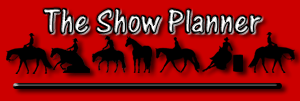 |
|
Show Horse Promotions Mary Murray
|
Collection for Timed Event HorsesAt first glance collection might seem like the last thing you would want for a timed event, but letís take a closer look. True collection occurs when the horse is in self-carriage. In true collection the horse is able to execute changes in speed or direction without losing his balance. A horse conditioned only for speed will lose agility and be harder to control because he canít respond efficiently and quickly to the riderís aids. The perfect example is the jumper that fights his rider all the way to the jump and, when finally released, jumps flat and takes down a pole. This type of horse may be more talented than he appears but often loses to the smoother more balanced jumper. In barrel events a horse that canít collect will often run past the barrels or turn wide circles around them. How to Train for Collection
Speed without balance is dangerous to the horse and rider. An unbalanced horse cannot rate his speed and is more likely to injure himself if he tries to make an adjustment. Unbalanced horses that are ridden for any length of time will get sore because they have not developed the proper muscles to support themselves, much less a rider. Incorporating balance exercises into your strength and speed conditioning program will help your horse be a better athlete and lessen his chance of injury. Contributed By: Madalyn Ward, DVM
|
||||||||||||
|
© 2000 - 2010 Show Horse Promotions The Show Horse Promotions web site is an informational web site, this information is subject to change without notice. Any use of, or actions taken based upon any of the information contained on this web site is done entirely at your own risk. Show Horse Promotions expressly prohibit you from republishing or redistributing this content without first receiving our written consent. By using this site, you agree not to hold us liable for any errors or delays in this content, or for any actions that you take in reliance thereon. This site contains links to other Internet sites. These links are not endorsements by us of any products or services in those sites, and we have not endorsed or approved any information in those sites. |
|
||||||||
